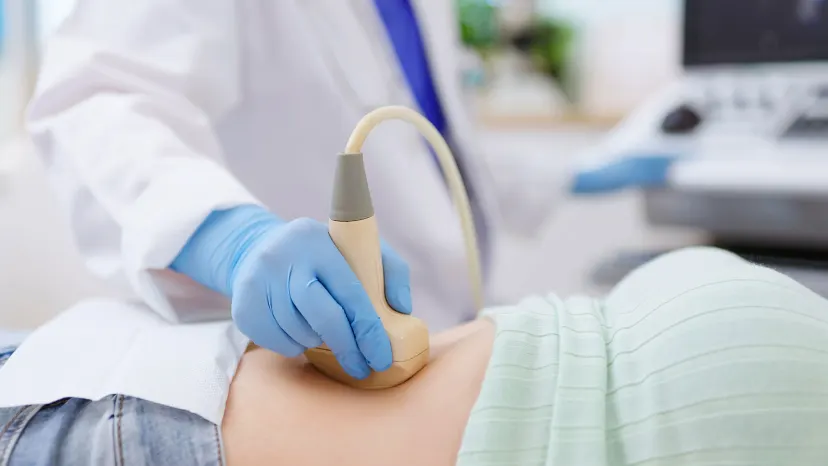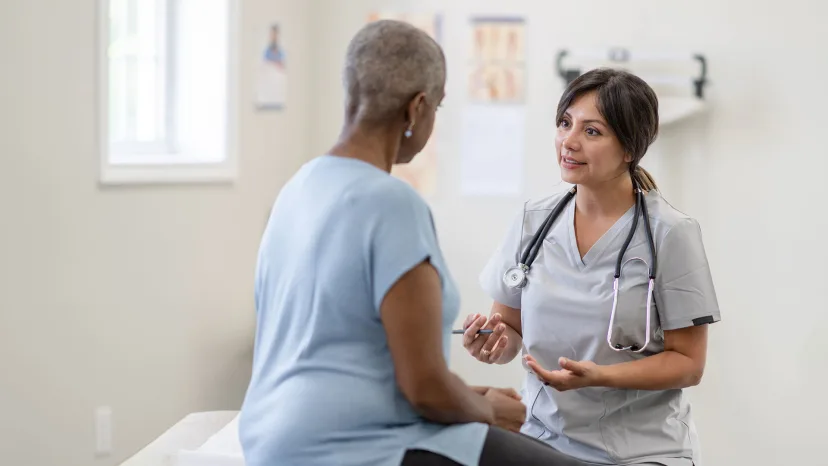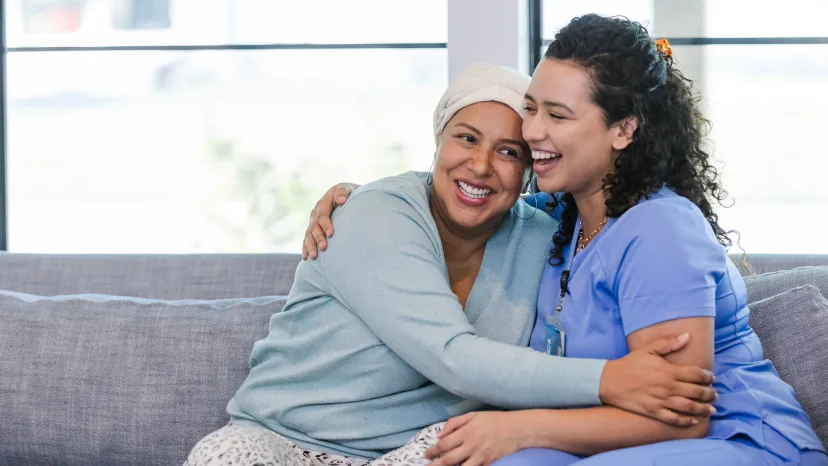Ovarian cancer
- What is ovarian cancer?
- How common is ovarian cancer?
- What are the types of ovarian cancer?
- What are the symptoms of ovarian cancer?
- When should you see a healthcare provider?
- What causes ovarian cancer?
- What are the risk factors for ovarian cancer?
- How is ovarian cancer diagnosed?
- What are the stages of ovarian cancer?
- What questions should you ask your healthcare provider?
- How is ovarian cancer treated?
- What are the possible complications of ovarian cancer?
- Can you prevent ovarian cancer?
- What is the outlook for ovarian cancer?
- Living with ovarian cancer
- Featured ovarian cancer articles
Introduction
Ovarian cancer is the growth of abnormal cells in one or both ovaries. Symptoms of ovarian cancer are often subtle at first and may not occur in the condition’s early stages. When diagnosed and treated early, ovarian cancer is often curable. Cancer that’s diagnosed in a later stage may also be treatable with surgery and chemotherapy.
Get the facts about ovarian cancer, including how it starts, what factors can increase your risk, and when to visit a healthcare provider (HCP). Learn how ovarian cancer is treated and what steps you can take to lower your risk and improve your health.
What is ovarian cancer?
Ovarian cancer is a disease that starts in the ovaries. The ovaries are small reproductive organs that produce eggs (ova) as well as the hormones estrogen and progesterone. A person with female reproductive organs has two ovaries, located on either side of the uterus (womb).
Ovarian cancer can also start in the fallopian tubes or the peritoneum. (The fallopian tubes are structures that connect the ovaries to the uterus, while the peritoneum is tissue that lines the ovaries and other organs in the abdominal area.)
How common is ovarian cancer?
Ovarian cancer is a relatively uncommon disease, but it’s among the leading causes of cancer death among women and people assigned female at birth (AFAB). According to the American Cancer Society (ACS), a person AFAB has about a 1 in 87 lifetime risk of developing ovarian cancer and a 1 in 130 risk of dying from the disease. (These figures don’t reflect borderline ovarian cancer, which are tumors that aren’t clearly cancerous and may not spread outside of the ovaries.)
Overall, ovarian cancer makes up about 1 percent of cancer diagnoses and 2.2 percent of cancer deaths. In 2024, the ACS estimates that ovarian cancer will be diagnosed in 19,680 people AFAB and cause 12,740 deaths.
What are the types of ovarian cancer?
There are several types of ovarian cancer. Each type is named according to the cell in which it begins:
- Epithelial ovarian cancer forms in the epithelial cells that cover the outside of the ovaries and other nearby structures. Around 95 percent of ovarian cancers start in epithelial cells. Fallopian tube and peritoneum cancers are also considered epithelial cancers.
- Germ cell ovarian cancer starts in reproductive cells that produce eggs.
- Stromal cell ovarian cancer forms in connective tissue cells that stabilize the ovaries and produce estrogen and progesterone.
Germ cell and stromal cell ovarian tumors are rare and may be treated differently than epithelial ovarian cancer. They’re generally easier to treat and are associated with more positive outcomes. Benign (noncancerous) tumors can also form in the ovaries.
Small cell carcinoma of the ovary (SCCO) is another type of ovarian cancer that’s especially rare. Researchers aren’t sure whether SCCO begins in epithelial cells, germ cells, or stromal cells. Collectively, SCCO, germ cell ovarian cancer, and stromal cell ovarian cancer are sometimes referred to as non-epithelial ovarian cancer.
Ovarian tumors vs. ovarian cysts
A cancerous ovarian tumor is a solid mass of abnormal cells. An ovarian cyst, on the other hand, is a pocket or sac of noncancerous cells that’s usually filled with fluid. Ovarian cysts are common, especially among people who haven’t reached menopause. These growths may come and go on their own along with a person’s menstrual cycle. It’s estimated that 10 percent of people AFAB experience ovarian cysts.
Ovarian cysts are typically painless, although some may cause symptoms like abdominal discomfort, bloating, and pain with sexual intercourse. Most ovarian cysts are simple cysts, which means they’re filled with fluid and resolve on their own. Complex cysts, which are less common, are solid or filled with blood.
Many complex ovarian cysts are harmless, but some may eventually turn cancerous. A 2019 study published in JAMA Internal Medicine found that 6.5 percent of people AFAB aged 50 or older with complex ovarian cysts may be diagnosed with ovarian cancer within 3 years.
If you’ve been diagnosed with an ovarian cyst, your HCP will likely want to monitor the cyst’s size and growth. This can be done with ultrasonography, a painless imaging test that uses sound waves to create pictures of the inside of your body. More frequent monitoring may be recommended if a cyst is complex or develops after menopause.
What are the symptoms of ovarian cancer?

Ovarian cancer may not cause noticeable symptoms in its early stages. Signs typically become more evident as the cancer progresses. When they do appear, the most common ovarian cancer signs and symptoms include:
- Abdominal bloating or an increase in abdominal size
- Abdominal or pelvic pain
- Quickly feeling full when eating
- Frequent urination or feeling an urgent need to urinate (also called urinary urgency)
Less commonly, ovarian cancer can cause signs and symptoms such as:
- Constipation or other changes in bowel habits
- Fatigue
- Low back pain
- Upset stomach
- Pain during sexual intercourse
- Weight loss with abdominal swelling
- Changes in your menstrual period, such as bleeding in between periods and unusually heavy periods
- Bleeding after menopause
When should you see a healthcare provider?
Speak with an HCP if you develop any changes in your health that concern you. It’s particularly important to visit an HCP if you experience possible ovarian cancer symptoms that are new or persist for longer than two weeks. This might include bloating, abdominal or pelvic pain, urinary urgency or frequency, or trouble eating as much as you usually do.
Keep in mind that ovarian cancer is relatively uncommon. Its symptoms are shared by many noncancerous conditions like ovarian cysts, premenstrual syndrome (PMS), uterine fibroids, and irritable bowel syndrome (IBS). Only an HCP can diagnose the cause of your symptoms, rule out serious conditions like cancer, and recommend appropriate treatment.
There currently isn’t a standard method of screening for ovarian cancer. Pap tests (also called pap smears), which screen for signs of cervical cancer, cannot detect ovarian cancer. To maintain overall health and help identify potential issues early, it’s important to visit an HCP at least once a year for a physical exam.
What causes ovarian cancer?
Ovarian cancer forms when abnormal cells in the ovaries begin to grow and multiply out of control and live beyond their typical lifespan. Eventually, excess abnormal cells can bind together and form tumors. Cancer cells can then break off from tumors and travel (metastasize) to other parts of the body.
This abnormal cell growth may be caused by an unusual change in DNA called a mutation. (DNA is a kind of molecule containing genetic information that tells cells how to develop and divide.) What exactly triggers mutations in DNA and unusual cell behavior is unclear, but researchers have identified several risk factors that can increase a person’s likelihood of developing ovarian cancer.
What are the risk factors for ovarian cancer?
There are several well-known risk factors for ovarian cancer, including:
Age: Ovarian cancer is more common after menopause and rarely occurs in people younger than 40. It’s most often diagnosed between ages 55 and 64.
Family medical history: If a close blood relative (such as a parent or sibling) has or had ovarian cancer, you may have an elevated risk of the condition, as well. Family cancer syndromes also increase the chances of ovarian cancer. These are patterns of cancer occurrence that may be seen in families. Up to 25 percent of ovarian cancers are associated with family cancer syndromes, according to the American Cancer Society (ACS).
Hereditary breast and ovarian cancer syndrome is one type of family cancer syndrome. It’s linked to mutations in certain genes called BRCA1 and BRCA2. (BRCA genes ordinarily help prevent cancer, but having a mutation means they may work less effectively.)
The ACS notes that people AFAB with a BRCA1 gene mutation have a 35 to 70 percent chance of developing ovarian cancer. For those with a BRCA2 gene mutation, their risk is 10 to 30 percent by age 70. (By comparison, the lifetime risk of ovarian cancer among the general population in the United States is less than 2 percent.)
Less common family cancer syndromes linked to ovarian cancer include Lynch syndrome, Peutz-Jeghers syndrome, and MUTYH-associated polyposis.
Ethnicity: Mutations in BRCA1 and BRCA2 genes that can lead to ovarian cancer are around 10 times more common in people of Ashkenazi (European) Jewish descent than in the general population.
Reproductive factors: People who have never given birth or who experience pregnancy for the first time after age 35 have an elevated risk of ovarian cancer.
Menopausal hormone therapy: Taking the hormones estrogen or progesterone after menopause is associated with an elevated risk of ovarian cancer.
Weight: Being overweight or obese increases your risk of ovarian cancer and various other diseases. It may also negatively affect ovarian cancer outcomes.
Other medical conditions: Having a history of uterine (endometrial) cancer, colon cancer, breast cancer or endometriosis may increase your chances of ovarian cancer.
Smoking: Smoking cigarettes raises your risk of mucinous ovarian carcinoma, an uncommon subtype of epithelial ovarian cancer.
Fertility treatment: Research results are mixed, but some studies suggest that having in vitro fertilization (IVF) may increase the risk of borderline ovarian cancer.
It’s important to note that having one or even several ovarian cancer risk factors doesn’t mean you’re sure to be diagnosed. On the other hand, it’s possible to develop ovarian cancer without having any known risk factors. If you have multiple ovarian cancer risk factors, it’s important to be mindful of any changes in your health. Speak with an HCP promptly if you notice any potential symptoms.
How is ovarian cancer diagnosed?

Diagnosing ovarian cancer begins with a physical exam and review of symptoms. Your HCP may ask you about your personal and family medical histories, lifestyle habits, and changes you may be experiencing in your health.
Your HCP may perform a pelvic exam to check for unusual changes, such as collected fluid or an enlarged ovary. During a pelvic exam, an HCP inserts a gloved finger into the vagina while gently pressing against the abdomen to feel for abnormalities in the pelvic area.
Following an exam, your HCP might order tests to rule out or diagnose ovarian cancer. These can include:
Imaging tests
Several imaging tests can visualize the size and shape of your ovaries, screen for abnormalities, and check for signs of metastatic cancer (cancer that has spread to other areas of the body). Imaging tests may include:
Ultrasound: This form of imaging uses sound waves to produce moving images displayed on a video screen. It can expose unusual growths on the ovaries and help differentiate a cyst from a cancerous tumor.
Computed tomography (CT): These scans use X-rays to create cross-sectional images of the inside of your body. They may be used to identify large ovarian tumors or signs that cancer has spread.
Positron emission tomography (PET): This type of scan uses a small amount of radioactive sugar to highlight areas of cancer in the body. It can provide additional clarity on potential areas of cancer identified with other imaging tests. A PET scan may be performed alongside a CT scan (called a PET/CT scan).
Other imaging tests, such as magnetic resonance imaging (MRI), chest X-rays, and colonoscopies can help determine if ovarian cancer has spread to specific areas of the body.
Blood tests
Blood tests can assess your overall health, measure blood cell levels, and help evaluate kidney and liver function. (Ovarian cancer that has spread can disrupt the health of these organs.)
You may also receive a blood test to screen for tumor markers that suggest the presence of ovarian cancer. For example, a CA (cancer antigen) 125 test checks for a protein that exists on the outer layer of many ovarian cancer cells.
A blood sample is also used for genetic testing, which screens for inherited gene mutations that raise your risk of ovarian cancer. Learning if you have a gene mutation can also help guide treatment decisions if you receive an ovarian cancer diagnosis.
Surgery
Your HCP may recommend a laparoscopy to view your ovaries and surrounding tissues in your pelvic area. This minimally invasive procedure involves inserting a thin, lighted instrument called a laparoscope into a small incision in the lower abdomen. A camera attached to the laparoscope sends live video to a monitor in the operating room, allowing the HCP to examine the ovaries and nearby structures. This procedure is often used to help stage ovarian cancer (which determines how much cancer is in your body).
An HCP must perform a biopsy to definitively diagnose ovarian cancer. A biopsy involves surgically removing suspected cancerous tissue from the ovaries, which is then examined under a microscope. If you have a buildup of fluid in your abdomen (called ascites), a sample of this fluid can also be drawn out with a needle and tested for cancer cells.
What are the stages of ovarian cancer?
Staging is used to assess how much cancer is in your body and if (or how far) it has spread. Assigning a stage to your cancer also helps your HCP determine what types of treatment may be best for you.
Ovarian cancer is typically staged from 1 to 4, with stage 4 indicating the most advanced disease. In general, ovarian cancer stages are as follows:
- Stage 1 ovarian cancer has not spread outside of the ovaries or fallopian tubes, although cancer may be present in the space immediately surrounding the ovaries (called the peritoneal cavity).
- Stage 2 ovarian cancer has spread to the uterus or other pelvic structures, though it has not reached nearby lymph nodes. (Lymph nodes are small, bean-shaped organs that are located throughout the body. They collect a fluid called lymph that contains immune cells.)
- Stage 3 ovarian cancer has spread to the abdominal cavity or surrounding lymph nodes. Liver or spleen function may also be disrupted.
- Stage 4 ovarian cancer has spread to distant areas of the body. This may include the intestines, stomach, lungs, brain, spinal cord, or into the lymph nodes in the groin or chest.
An HCP may also describe ovarian cancer as being localized, regional, or distant:
- Localized ovarian cancer is confined to the ovaries or fallopian tubes.
- Regional ovarian cancer has reached surrounding lymph nodes or other nearby structures.
- Distant ovarian cancer has reached distant areas of the body, such as the lungs. More than half of all ovarian cancers are diagnosed in this stage.
What questions should you ask your healthcare provider?

If you’ve received an ovarian cancer diagnosis (or are caring for a loved one who has), it’s important to learn about the disease and find answers to your questions. Having a clear understanding of ovarian cancer and how it may affect your daily life can help you make confident decisions as you go through treatment.
Some basic questions you can ask about ovarian cancer include:
- What type and stage of ovarian cancer do I have?
- Where precisely is my cancer located?
- What is my prognosis (my prospects of recovery)?
- What are my treatment options? Can you explain the risks and benefits of each?
- How long does ovarian cancer treatment usually take?
- How can I manage ovarian cancer symptoms or side effects of treatment?
- Should I change my diet during treatment? What foods or beverages should I consume more or less of?
- Should I exercise during ovarian cancer treatment?
- Can I still work or attend school during ovarian cancer treatment?
- How can I best manage ovarian cancer with other conditions that I have?
- Can I still become pregnant? How can I preserve my fertility?
- Should I consider speaking with a licensed mental health provider?
- Can you direct me to an ovarian cancer support group?
How is ovarian cancer treated?
The details of your ovarian cancer treatment will depend on the cancer’s stage and type, as well as your age and overall health. Ovarian cancer may be treated by a number of different healthcare professionals, including:
- Gynecological oncologists: These are medical doctors who specialize in treating female reproductive cancers like ovarian cancer.
- Surgeons: These are medical doctors who specialize in performing surgical operations.
- Medical oncologists: These are medical doctors who specialize in treating cancer with medicines, such as chemotherapy.
Surgery and chemotherapy are the primary treatments for most ovarian cancers. Your ovarian cancer treatment plan may involve a combination of approaches, including the following:
Surgery for ovarian cancer
Surgery is performed to remove as much cancer from the body as safely possible. There are several types of surgery that may be used to treat ovarian cancer. These include:
Salpingo-oophorectomy: A unilateral (one-sided) salpingo-oophorectomy removes one ovary and its adjoining fallopian tube. A bilateral (two-sided) salpingo-oophorectomy removes both ovaries and fallopian tubes. Someone who has this type of surgery may still be able to become pregnant with frozen embryos or eggs or eggs from a donor.
Hysterectomy with salpingo-oophorectomy: This removes the uterus along with the ovaries and fallopian tubes. Pregnancy isn’t possible following a hysterectomy.
Omentectomy: This removes the omentum, which is a layer of fatty tissue that covers the intestines. Ovarian cancer often spreads to the omentum.
Lymphadenectomy: This removes lymph nodes that contain cancer. In someone with ovarian cancer, the pelvic and/or para-aortic (abdominal) lymph nodes may be surgically removed.
Cytoreduction: Also known as debulking surgery, a cytoreduction removes a large amount of cancerous tissue in cases of late-stage ovarian cancer. It may involve removing various organs (or parts of organs) in the abdominal area, such as the liver, spleen, bladder, intestines, and peritoneal tissues.
Chemotherapy for ovarian cancer
Chemotherapy (chemo) uses potent drugs to destroy or damage ovarian cancer cells in the pelvic area and throughout the body. It may be given as a pill or intravenously (through an IV) in several rounds. Chemo can be given before surgery to shrink tumors and make them easier to remove or after surgery to help eliminate any cancer cells that remain.
Hyperthermic intraperitoneal chemotherapy (HIPEC) may be recommended for some people with ovarian cancer. This type of chemo is heated and fed directly into the abdomen. The medicine is then drained after remaining in the abdomen for a set time period.
Treatment for many other cancers often combines chemotherapy with radiation therapy, which uses high-energy X-rays to destroy or damage cancer cells in a specific area. Treatment for ovarian cancer, however, usually doesn’t involve radiation therapy. Chemo alone has been shown to be more effective in treating ovarian cancer. Sometimes, radiation therapy may be recommended to address ovarian cancer cells that have spread to other areas of the body (such as the spinal cord or brain).
Targeted therapy for ovarian cancer
Targeted therapy uses drugs to disrupt the workings of ovarian cancer cells. While it doesn’t destroy the cancer itself, it does help prevent tumors from growing and spreading through the body. Eventually, damage caused by targeted therapy can cause cancer cells to die.
There are multiple types of targeted therapy drugs. Your HCP may recommend testing the cancer cells in your body to see what type of drug would be most effective.
Immunotherapy for ovarian cancer
Immunotherapy uses the disease-fighting power of the body’s immune system to help identify and destroy ovarian cancer cells. Ordinarily, cancer cells contain proteins that help them hide from the immune system. Immunotherapy uses drugs to help expose cancer cells, allowing the immune system to find and attack them.
Hormone therapy for ovarian cancer
Some types of ovarian cancer feed off the hormone estrogen. Taking certain other hormones or hormone-blocking drugs can help stop or reduce estrogen production or prevent estrogen from reaching areas affected by cancer. This deprives the cancer of the estrogen that it uses to grow.
Ovarian cancer clinical trials
A clinical trial is a research study that involves human volunteers. Preventing ovarian cancer and improving outcomes for people with the disease are major focuses of current research initiatives. To learn if you’re a candidate for a clinical trial, speak with your HCP. You can also browse ongoing ovarian cancer clinical trials at ClinicalTrials.gov or the National Cancer Institute (NCI) website.
Many clinical trials focus on evaluating new or unproven cancer treatments, so participation comes with some measure of risk. It’s important to communicate with your HCP and weigh the pros and cons of joining a clinical trial before making your decision.
Supportive care for ovarian cancer
Supportive care (also known as palliative care) aims to improve quality of life for people with ovarian cancer by tending to their physical, emotional, and practical needs. It addresses the whole person, not just the cancer. Supportive care isn’t reserved for people with incurable diseases. Rather, it’s recommended for people of all ages with any type and stage of cancer as well as their loved ones and caregivers.
Supportive care providers can include medical doctors, nurses, physical therapists, social workers, mental health providers, chaplains, dietitians, and various other professionals.
Examples of supportive care for ovarian cancer may include:
- Medical treatment to relieve cancer symptoms and improve comfort
- Physical therapy or rehabilitation
- Nutritional advice
- Financial guidance regarding treatment costs
- Spiritual support
- Counseling
- Caregiver support
Receiving supportive care as soon as possible after your diagnosis can help you cope with the physical and emotional side effects of ovarian cancer and its treatment. Your HCP can recommend appropriate supportive care services or refer you to providers they know and trust.
Hospice care is a form of supportive care that’s beneficial for people who are near the end of life. The primary goal of hospice care is to keep the patient as comfortable as possible while helping caregivers and loved ones make necessary arrangements and plan for the future.
To learn more about hospice care for ovarian cancer or to find a provider in your area, browse resources from the American Cancer Society.
What are the possible complications of ovarian cancer?
Ovarian cancer and its treatment may lead to complications. These may include:
Early menopause: Unless you’ve already been through menopause, having both of your ovaries surgically removed will bring on this process, regardless of your age. Menopause typically begins between the ages of 45 and 55. It signals the end of a person’s menstrual cycle.
Common symptoms of menopause include:
- Mood swings
- Hot flashes
- Trouble sleeping
- Vaginal dryness
- Fatigue
- Itchy or dry skin
Treatments are available to address menopause symptoms. For instance, using a lubricant can help improve vaginal dryness and make sex more comfortable. Hot flashes may be addressed with medication or a variety of lifestyle changes.
Fatigue: Cancer and treatments like chemo can make you feel tired and weak. That fatigue is not always resolved by simply getting more sleep. Most people gradually regain their energy after cancer treatment. In the meantime, your HCP can suggest strategies to help reduce cancer-related fatigue, such as making healthy diet changes or engaging in gentle exercise.
Lymphedema: Having multiple lymph nodes surgically removed from an area of the body can lead to lymphedema. This occurs when lymph fluid (which ordinarily drains from tissues in your body via the lymphatic system) builds up and causes swelling. Many people with ovarian cancer experience lymphedema in their legs after they have had surgery that involves removing lymph nodes from the abdomen and pelvic area.
Lymphedema can be improved or managed with proper treatment. Your HCP may recommend techniques to ease swelling, such as propping your legs up on a pillow or using compression wear. They might also refer you to a specialist for more advanced care, which may include microsurgery to help restore lymph fluid drainage.
Ascites: Many people with ovarian cancer experience a buildup of fluid in their abdomen. This is called ascites. Symptoms of ascites include abdominal swelling, pain, and pressure, which can leave you feeling short of breath. Your HCP can drain fluid from your abdomen to relieve these symptoms.
Similarly, fluid can collect around the lungs if cancer has spread to the chest area. This is called pleural effusion.
Bowel problems: Surgery, chemo, or radiation therapy (a treatment rarely used for ovarian cancer) to the abdominal area may cause temporary changes in bowel habits, such as constipation or diarrhea. Bowel blockages can also occur after surgery due to scar tissue forming or as a result of tumors pressing against the intestines. In some cases, surgery may be necessary to remove bowel blockages and improve digestive health.
Sexual dysfunction: Ovarian cancer can lead to sexual dysfunction in various ways. Treatment-induced menopause may lower sex drive and cause vaginal dryness that can make sex uncomfortable. Radiation therapy and surgery may result in the buildup of scar tissue that can cause the vagina to narrow. Cancer-related fatigue and coping with the challenges of living with cancer can make you lose interest in sex.
It's helpful to be candid with your HCP about any sexual side effects you experience. Many of these issues can be managed or improved with treatment. Your HCP may also refer you to a specialist, such as a mental health provider or sex Ovarian cancer and fertility
One of the most notable potential complications of ovarian cancer is infertility, or an inability to become pregnant. Radiation therapy to the pelvic area can affect fertility and a hysterectomy (surgery to remove the uterus) makes it impossible to carry a fetus.
Pregnancy is still possible following unilateral salpingo-oophorectomy surgery, which leaves one ovary in place. You may even be able to sustain a pregnancy without ovaries by undergoing in vitro fertilization (IVF). This fertility treatment involves combining an egg and sperm in a lab, then implanting the fertilized egg directly into the uterus.
Communicating your fertility goals with your HCP before starting ovarian cancer treatment is important. Your HCP may be able to provide fertility-sparing treatments, recommend a fertility specialist, or refer you to a mental health provider who can help you navigate the stress of cancer treatment and the prospect of infertility.
Can you prevent ovarian cancer?

While there’s no way to definitively prevent the disease, there are some factors that may reduce the risk of ovarian cancer. These include:
- Birth control pills: Taking birth control pills (oral contraceptives) that contain estrogen and progesterone for five years or longer is associated with a lower risk of ovarian cancer.
- Childbirth: Giving birth to a baby reduces ovarian cancer risk, as does breastfeeding for at least one year.
- Surgery: Receiving prophylactic (preventive) surgery to remove the ovaries (bilateral salpingo-oophorectomy) or to remove the uterus and ovaries (hysterectomy with salpingo-oophorectomy) can significantly lower your risk of ovarian cancer. Some HCPs may recommend preventive surgery for people with an elevated risk of ovarian cancer, such as those with BRCA1 or BRCA2 gene mutations.
It's always beneficial to address any changeable ovarian cancer risk factors you might have. For instance, achieving and maintaining a healthy body weight and quitting smoking can help you reduce your risk for ovarian cancer and maintain your overall health.
What is the outlook for ovarian cancer?
According to data collected between 2014 and 2020 by the NCI Surveillance, Epidemiology, and End Results (SEER) Program, the five-year relative survival rate for all types and stages of ovarian cancer combined is 50.9 percent. This means nearly 51 percent of people with ovarian cancer diagnosed in any stage were still alive five years after their diagnosis. (By comparison, the five-year ovarian cancer survival rate in 1975 was 34 percent.)
The five-year relative survival rate for ovarian cancer by stage at diagnosis is:
- 91.9 percent for localized cancer
- 71.5 percent for regional cancer
- 31.4 percent for distant cancer
Most people who die of ovarian cancer are between the ages of 65 and 74.
Ovarian cancer is a dangerous disease, but there are reasons for optimism. Death rates have dropped 40 percent since 1975 and the number of people being diagnosed with ovarian cancer has steadily declined in recent decades. This is most likely due to an increased use of oral contraceptives (birth control) and a decrease in use of menopausal hormone therapy.
It’s also important to note that current ovarian cancer survival rates reflect outcomes of people who were diagnosed several years ago. These figures don’t consider each person’s health before cancer, their treatment regimen, or what type of ovarian cancer they had. (For instance, germ cell and stromal cell ovarian cancers have higher survival rates than epithelial ovarian cancers.) Every individual is unique, so your prognosis and cancer experience will be, as well.
Living with ovarian cancer

A wide range of emotions can come with an ovarian cancer diagnosis. You may experience confusion, sadness, anger, or a combination of difficult feelings. While there’s no right or wrong way to feel, there are a few steps you can take to help you cope with distressing emotions and to feel better while living with ovarian cancer.
Lean on others for support
You may receive offers of help from friends and family. While you may not want to interact with others during a difficult time, consider accepting that help. It can also help to share your thoughts and feelings with those who care about you. Though you may be inclined to spend time alone, isolating yourself may actually make you feel worse.
Your healthcare team is also there to support you through your ovarian cancer experience. Don’t hesitate to reach out to your HCP if you have questions or experience difficulties. Voicing your concerns and learning more about your condition can give you a better idea of what to expect during treatment.
Prioritize your mental health
Some people with a cancer diagnosis find it difficult to be open and vulnerable with those they’re close with. Regardless of how open you are with your feelings, speaking with a mental health provider such as a counselor, clinical social worker, or psychologist can be helpful. You may also want to consider joining an in-person or online cancer support group, where you can connect with people who are facing similar challenges.
Getting enough rest, participating in hobbies you enjoy, and trying stress management techniques like journaling or deep breathing can also help you take care of your mental health and feel better.
Nourish your body
No eating plan can prevent or treat ovarian cancer, but enjoying a balanced, nutrient-rich diet can help you boost your energy levels, maintain your strength, and support your immune system as you go through treatment.
Your healthcare team is your best source for individualized dietary advice. Some general tips include:
Eat your plants. Consider making plant foods (instead of animal protein) the centerpiece of your meals. You don’t need to become a vegetarian; just try to fill your plate with more vegetables, fresh fruits, nuts, legumes, and whole grains like quinoa, oats, and brown rice.
Stay hydrated by drinking enough water. Adding sliced lemons, limes, cucumbers, or a sprig of mint to your water can add flavor and make plain water more enjoyable. Eating foods with a high water content (such as watermelon, soups, apples, cucumbers, and fruit popsicles with low sugar) can also help prevent dehydration.
Opt for smaller meals. Having ovarian cancer and receiving treatments like chemo can shrink your appetite. To ensure you get enough nutrients, try to eat multiple small meals or snacks throughout the day instead of two or three large meals. You may also find it easier to get the nourishment you need by drinking smoothies or sipping on soups.
Limit alcohol. Excessive alcohol consumption can lead to dehydration and weaken your immune system. Consider avoiding alcohol or limiting your intake while going through treatment.
The Centers for Disease Control and Prevention (CDC) advises women and people AFAB to consume no more than one alcoholic drink per day. One “drink” translates to 12 ounces of beer, 8 ounces of malt liquor (including malt-based seltzers), 5 ounces of wine, or 1.5 ounces of distilled spirits like vodka and rum.
Learn more about ovarian cancer
Contact a healthcare provider if you’d like to learn more about ovarian cancer symptoms, preventive methods, and your individual risk factors for the disease. You can also browse patient and caregiver resources from organizations like the Centers for Disease Control and Prevention and the American Cancer Society.
Featured ovarian cancer articles

American Cancer Society. Key Statistics for Ovarian Cancer. Last revised January 14, 2024.
American Cancer Society. Ovarian Cancer Risk Factors. Last revised January 26, 2021.
American Cancer Society. Radiation Therapy for Ovarian Cancer. Last revised April 11, 2018.
American Cancer Society. Signs and Symptoms of Ovarian Cancer. Last revised April 11, 2018.
American Cancer Society. Survival Rates for Ovarian Cancer. Last revised March 1, 2023.
American Cancer Society. Tests for Ovarian Cancer. Last revised November 17, 2022.
American Society of Clinical Oncology. Cancer.Net. Types of Palliative and Supportive Care. Last reviewed November 2022.
Berg S. What Doctors Wish Patients Knew About Ovarian Cancer Prevention. American Medical Association. Published November 11, 2022.
Canadian Cancer Society. Supportive Care for Ovarian Cancer. Accessed April 11, 2024.
Cancer Council Victoria. Ovarian Cancer. Last updated April 2022.
Centers for Disease Control and Prevention. Basic Information About Ovarian Cancer. Last reviewed June 14, 2023.
Centers for Disease Control and Prevention. Dietary Guidelines for Alcohol. Last reviewed April 19, 2022.
Centers for Disease Control and Prevention. What Can I Do to Reduce My Risk of Ovarian Cancer? Last reviewed June 14, 2023.
Centers for Disease Control and Prevention. How is Ovarian Cancer Treated? Last reviewed June 14, 2023.
Cleveland Clinic. Ovarian Cancer. Last reviewed November 14, 2022.
Johns Hopkins Medicine. Ovarian Cancer. Accessed April 9, 2024.
Mayo Clinic. Ovarian Cancer. Last reviewed May 9, 2023.
National Cancer Institute Surveillance, Epidemiology, and End Results Program. Cancer Stat Facts: Ovarian Cancer. Accessed March 28, 2024.
Ovarian Cancer Research Alliance. Managing Diet for Ovarian Cancer. Published November 28, 2022.
Ovarian Cancer Research Alliance. Science Made Simple: Ovarian Cysts and Ovarian Cancer.
Ovarian Cancer Research Alliance. What is Ovarian Cancer? Accessed April 9, 2024.
Pelham V. Understanding Ovarian Cysts. Cedars Sinai. Published April 4, 2022.
Smith-Bindman R, Poder L, Johnson E, Miglioretti DL. Risk of Malignant Ovarian Cancer Based on Ultrasonography Findings in a Large Unselected Population. JAMA Intern Med. 2019 Jan 1;179(1):71-77.





